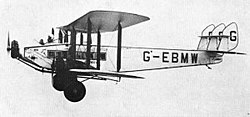 de Havilland Hercules City of Cairo, a sister aircraft to City of Jerusalem | |
| Accident | |
|---|---|
| Date | 6 September 1929 |
| Summary | Pilot error, stall, loss of control |
| Site | Jask Airport, Jask, Iran 25°39′13″N057°47′57″E / 25.65361°N 57.79917°E |
| Aircraft | |
| Aircraft type | de Havilland DH.66 Hercules |
| Aircraft name | City of Jerusalem |
| Operator | Imperial Airways |
| Registration | G-EBMZ |
| Passengers | 1 |
| Crew | 4 |
| Fatalities | 3 |
| Injuries | 2 |
| Survivors | 2 |
On 6 September 1929 a de Havilland Hercules three-engined biplane of Imperial Airways crashed on landing at Jask Airport, near the town of Jask in Iran on the Gulf of Oman. [1] The aircraft was carrying mail from the United Kingdom to India. [1] The pilot, a mechanic and a passenger were killed. [1] [a]